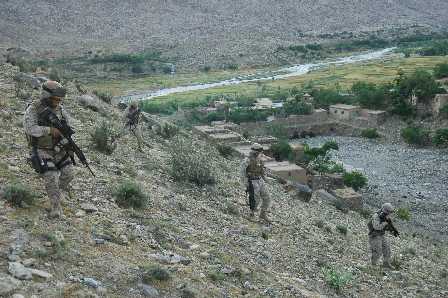 So, the Iraqi government is now limiting press freedom following enemy attacks. Afghans are also cracking down on media. And the U.S. is advising them both on information strategy in their newly formed “democracies.”
So, the Iraqi government is now limiting press freedom following enemy attacks. Afghans are also cracking down on media. And the U.S. is advising them both on information strategy in their newly formed “democracies.”AP-Wire, Yahoo News - No photos allowed after Iraqi blasts
http://news.yahoo.com/s/ap/20070515/ap_on_re_mi_ea/iraq_media_ban
This ban in Iraq will have the greatest impact on photographers, who will not be able to depict graphically the extent of attacks. Already, photographers are taking huge risks to obtain imagery in the aftermath of violent acts - so many risk their lives daily to cover the horror of war.
The reporters will then be forced later to piece together details – often relying on government-issued statements that have been vetted and prepared for public release. This limits reporters from recreating the reality of an event – and in turn allows the military and the government to control what information reaches the public.
Reporting in Iraq was always dangerous. On Jan. 18, 2004, while reporting for the Stars and Stripes, I covered a suicide car bomb attack on the Assassin’s Gate – the main entrance to the Green Zone, just block from the Tigris River. Dozens of charred bodies and wounded Iraqi filled the busy boulevard. U.S. soldiers arrived and created a perimeter, pushing reporters and grieving civilians across the bridge. My photographer and I ducked down some steps into an Iraqi neighborhood to remain near the blast site and get the story. Several times we had U.S. troops point their weapons at us, despite me yelling that we were American journalists from the Stripes. But we got the story, a compelling look at how our troops were attacked and their response.
Link: Stripes Story - CAR BOMB AT THE “MOTHER OF ALL CHECKPOINTS” (MOAC)
http://www.estripes.com/article.asp?section=104&article=19145&archive=true
It has steadily become worse for those assigned to cover attacks and combat missions. Security is a word that the military and the government use – I don’t think that word even applies to places like Baghdad anymore – especially for civilian journalists trying to cover the news.
But more importantly, there is a campaign against the release of the truth in press reports.
Link: Stripes Story - CAR BOMB AT THE “MOTHER OF ALL CHECKPOINTS” (MOAC)
http://www.estripes.com/article.asp?section=104&article=19145&archive=true
It has steadily become worse for those assigned to cover attacks and combat missions. Security is a word that the military and the government use – I don’t think that word even applies to places like Baghdad anymore – especially for civilian journalists trying to cover the news.
But more importantly, there is a campaign against the release of the truth in press reports.
Right now, the U.S. government and its contracted corporations provide advisors to government staff in both Iraq and Afghanistan. The public affairs and strategic communication professionals – if they are doing their job correctly – offer these emerging governments’ information tactics to control the release of sensitive information. Look at the company MPRI – which supplies many of these advisers – which is currently listing a position to fill for a “Mentor to the Chief of Information” for the Iraqi Defense Ministry. I wouldn’t be surprised to learn that either the U.S. State Department or the U.S. military pushed for this ban behind the scenes.
Both the enemy and the U.S. government are extremely aware of information warfare and strategy. The insurgents in Iraq and Afghanistan and our own counterinsurgency efforts rely on public support. Both the Insurgents and the U.S.-advised Iraqi and Afghan governments have a stake in what “bad” news gets reported through the press to the public.
Of course, in late 2005 the U.S. military faced a scandal when it was buying good news. Several press reports confirmed that the U.S. military paid newspapers to print strategically important news as part of its information operations (IO) campaign.
Link: 2005 Story on Iraq IO campaign – paying newspapers
http://seattletimes.nwsource.com/html/nationworld/2002654715_articles30.htmlOf course, in late 2005 the U.S. military faced a scandal when it was buying good news. Several press reports confirmed that the U.S. military paid newspapers to print strategically important news as part of its information operations (IO) campaign.
Link: 2005 Story on Iraq IO campaign – paying newspapers
In fact, when I worked in media relations at the U.S. military’s top headquarters in Afghanistan I routinely interacted with IO officers who worked to sway information toward a favorable outcome – stopping short of allowing them to mislead or misinform the media for military gain – although they suggested that we add misinformation to press statements time and again. It did not happen in Afghanistan on my watch – we offered as much truth as security would allow.
Publicly, the military’s IO operators are kept in a dark corner and rarely discussed. They have limited information released to open source users about their tactics and strategy.
U.S. Military Information Operations
The Interior Ministry argues that the ban is to preserve evidence – not sure how a few photographers snapping photos will hinder the evidence collection process – even if there was a criminal charge to purse, the footsteps of reporters would not jeopardize that process. In fact, they are more concerned about the published photos affecting the public and offering details to the enemy.
Sadly, this crackdown will likely remain in place and limit what audiences within and outside Iraq can learn about such attacks. The government has guns to enforce it. Even cavalier complaints by organizations such as Reporters Without Borders – whose fourth estate (media) ethics originate with Thomas Jefferson – will have little affect on the Iraqi decision to enforce this ban.
This is also why recent articles – such as Damien Cave’s coverage (A1, 5-23-07) in the New York Times about U.S. troops wounded and killed during the search for captured U.S. troops – tend to shock the American public. The grim reality presented with on-the-spot reporting and photography captures the reality of war – without the spin control and influence of military and government information operations.
Both Iraq and Afghanistan have a recent history – before U.S.-led intervention – of state-controlled national press and heavily-monitored international coverage. Do you think Saddam or the Taliban allowed free reporting – everything was managed and censored. Now, under U.S. guidance – both governments are struggling to contain the press. In Kabul the Afghan Interior Ministry cracked down on local news outlets – raiding offices of local TV and targeting reporters who wrote something against what the government wanted presented.
Link: Afghan Media Crack Down http://www.miamiherald.com/578/story/104999.html
Military strategists – especially those in information operations – seek to limit what locals know, certainly limit what the enemy knows and subsequently limit what people in the U.S. and other Western countries know. With public support waning at home and plummeting among people within the battle zone – bad news reinforces their dissent.


No comments:
Post a Comment